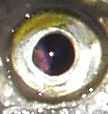
 |
Why do walleyes have such big eyes?: compelling results show that walleyes feed higher in the water column than barred surfperch. |
Walleyes are fun! They look like more of a caricature than a real fish with their large eyes and angular body shape. They are not large but their grabs are strong. After they take, they turn their deep sides to the current. Their mouth membranes are so delicate that you have to play them gently or risk dropping a lot of them. It you live for grabs then you will love walleyes!
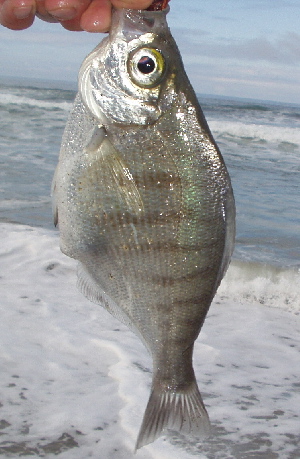
Walleye bites have been reported to be non-stop action for 1 to 2 hours. The best of the reports: 22 grabs for 22 consecutive casts and 75 walleye days! I have caught a few but have not gotten into long sustained walleye bites. I should have found them many times this season since I fish the same beaches frequently.
Walleyes feed higher in the water column than barred perch according to Rob Ketley. He thinks that I was fishing water below the school because I use a leadcore (LC-13) shooting head and heavy flies. I was skeptical at first because walleyes feed on the same forage that inhabits the bottom.
I started wondering why walleyes have such big eyes. The obvious answer is: the better to see things with them. At first, I suspected that they may be leader shy and I dropped my leader from 14-lb test to 12-lb test. Other fishermen who were experiencing the sustained walleye bites were using leaders from 10 to 12-lb test.
I finally found a school of walleyes on March 31, 2003 using 12-lb test leader (Click to read the gallery report). I got 10 walleye from 8 to 10 inches in a sustained bite. I was convinced that I found the answer but it did not repeat over the next several trips. Dave Sellers was skeptical. He hasn't found a salt water fish that is leader shy, and would fish with 20-lb test leader to prove that it is true for walleye.
The DFG website says that walleye often occur in dense schools 6 to 8 feet thick, comprised of several hundred fish. Mating takes place in October, November and December when the usual dense schools break up and the males and females pair off. Between 5 and 12 young, depending on the size of the mother, are born the following spring. They apparently return to the surf zone to give live birth which explains their spring abundance.
Did you ever get a funny feeling that fish were abundant but you weren't getting bit at all or having a really slow bite? Now I'm imagining schools of several hundred walleyes and I see my leadcore/heavy flies dragging the sand below the school, and the times that I caught only one or a few walleye with several hundred walleyes around.
It seems likely now that my walleyes have been outliers of the school - a few that happened to be feeding near the bottom. I have been exclusively using a leadcore (Cortland LC-13) shooting head and a heavy flies since 2001.
The physical differences between barred surfperch and walleye surfperch in the images below seems to support this idea. It looks like it would be difficult for walleyes to bottom feed like the barreds do. Their mouth has a definite cant upward as if their normal feeding mode is straight ahead or taking food from below. Their larger eyes may be an adaptation to pick moving forage from debris slicks coming out of turbulent areas. The walleyes also have a very tender mouth compared to the barreds. Whereas barred surfperch look like they feed looking downward, have smaller eyes and a robust mouth. They feed by oral winnowing (inhaling possible food rolling them around in their mouths then discarding non-food items) using their mouth like a vacuum cleaner. See Ken Hanley's Surfperch Academy article at Dan Blanton's Web Site for more information. Walleyes seem to depend more on sight in feeding than barred perch.


Rob Ketley invited me to fish together and compare our different approaches. He arranged a day that Dave Sellers would be fishing too. This was a great opportunity to get smarter about how walleyes feed so my plan was: first, given a large school of walleyes (with Rob and Dave in a sustained bite) that leadcore with heavy flies does not get bit often; second, prove by switching to less dense shooting head and lighter flies that I get into a sustained walleye bite; and, finally switch back to see if the sustained walleye bite ends.
I start at first light with 2 fly rod setups: my normal leadcore (LC-13) gear with two Surf Miki 3s and another set up with an old HiD Scientific Angler 30-ft (300 gr) head with 15# test amnesia shooting line and Blind Mikis (the same fly with no eyes to make it lighter).
I started with my LC-13 rod. I got 3 barred surfperch almost right away but the bite slowed down. One was the nice 12-inch perch below.
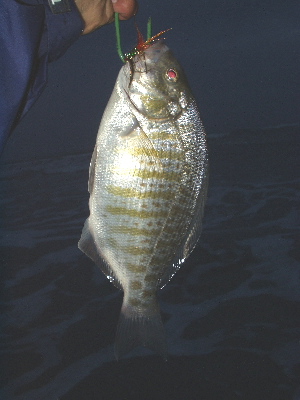
Rob Ketley shows up and we fished together. The bite was still slow but we were picking up a few. Dave Sellers arrives with his rottweiler, Annie (to look at her face, you would say she is smiling). Annie must radiate vibrations that attract walleyes because for the next 45 minutes, both Dave and Rob had many episodes of continuous bites on large walleyes. This picture shows Dave with one his many large walleyes. Rob Ketley shows in the background getting bite after bite.
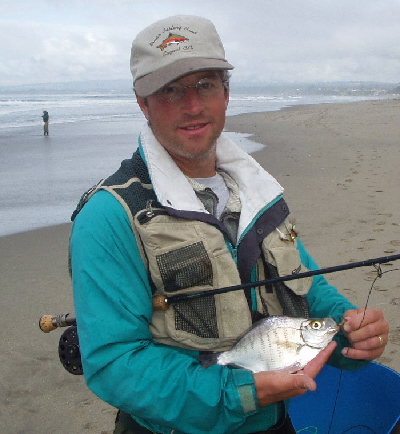
I got a few barred perch but I was not in sustained bite. I switched to HiD for a while but casting was so much harder that I switched back. The contrast was really bad! I think Rob and Dave even started to feel sorry for me. Dave let me move into his sweet spot. Rob let me try his rod set-up. I tried Dave's rod too. I didn't cast either of them well enough. Nothing helped and I went back to my leadcore set-up when I finally got a few nice barred including one that was 2-lbs. It made me feel a little better. Sellers and Ketley had a great bite on almost all walleyes and I had a slow period and caught a few barred perch. These results give compelling evidence that leadcore/heavy flies do not participate in a sustained walleye bite.
Rob left for work so I continued fishing with Dave. I was determined to get into a sustained walleye bite so I switched to the HiD rod with light flies again. I got used to casting and finally started to pick up large walleye! I got several before the bite seemed to slow.
Dave (having caught a lot of walleyes) decided to quit, return to his truck to change and run Annie on the beach. In the time he was gone (30 to 45 minutes), the bite picked up again and I had a continuous bite on almost exclusively walleyes. The photograph below shows a typical walleye. The bite lasted for around 1 1/2 hours overall. Dave jogged by as I landed a walleye and continued to run down the beach. I was happy he witnessed the event. These results indicate strongly that using less dense shooting head and lighter flies can transform a slow bite on barreds into a hot bite on walleyes. I caught around 20 walleye in this holding water.
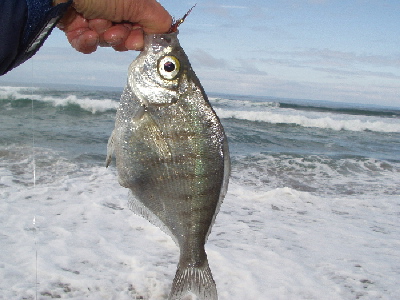
Since the bite was still strong, I switched to leadcore and heavy flies and stopped getting walleyes. The great bite continued but now I was getting exclusively barred perch. I picked up several, mostly larger ones. The last one was the nice fat 2 1/2-lbs, 14-inch barred surfperch below. I landed it as Dave was jogging back so he was a witness again. He took a few pictures and considered running back to get his gear. I continued to cast but it seemed the larger perch had left.
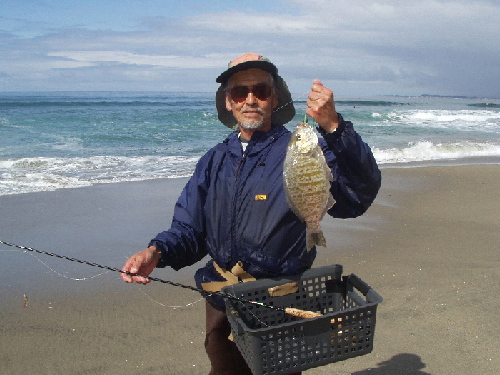
I switched back to HiD with light flies again but by then the tide's change caused the fish to move out.
By the way, Dave Sellers did fish with 20-lb test leader all day. He participated fully in the sustained walleye bite. It looks likely that walleye are not leader shy. I have switched back to 14-lb test leader because of this.
The results of this day's fishing show that walleyes feed higher in the water column than barred perch. If you live for grabs and want a lot of them, fish your favorite Santa Cruz area cut using conventional heads and lighter flies. If you want to maximize the odds of getting barred perch (especially large barred perch) use leadcore and weighted flies.
Some contrary evidence exists: (1) decent walleye bites using spinning gear and grubs. I have heard of good grub fishermen who have had great walleye days catching half walleyes and half barreds. The 1/2 to 1 1/2 oz egg sinkers used tracks the bottom well and you would expect the bite to favor barred perch, (2) good walleye bites using flies. You will find a few examples in the gallery reports. I have also had decent walleye bites with leadcore/heavy fly set-ups but not often and probably in unique holding water in which decent concentrations of walleyes see a bottom-bouncing fly. Click to my first report of a sustained walleye bite on March 31, 2003. Jim T has also had some good walleye bites using leadcore and heavy flies. I suspect that this has all been in shallower water or because of other conditions that expose more of the school a leadcore retrieved heavy fly.
In the walleye season, I have a choice of taking two fly rods or taking one and specializing my targeting. Dave Sellers tested a technique of using a type 6 shooting head (very dense but less then leadcore) and counting down if he wants to target barred perch and immediately retrieving if he wants walleyes. Using this technique, he got his catch ratio from predominately walleyes to 50/50 walleye/barred.
My basic set-up is going to stay leadcore and weighted flies because I prefer the improved odds of hooking large barred perch. You can see quite a few large barred perch in the galleries, independent of season and water conditions. A lot of fly fishermen don't like using leadcore on the beach and feel it is difficult to cast. I prefer it, Jim T prefers it and it makes casting easier under all conditions of wind and surf. It eases line control because it has less drag to water's hydraulic forces and it enables the use of a light fly rod under all conditions. I use a 6-weight exclusively (even under moderate winds and heavy surf).
I also enjoy a hot walleye bite so I am still looking for ways that I can adapt my basic leadcore/heavy fly set-up to get into sustained walleye bites. I've thought about adding a twist on floating indicator midpoint on my leader. I've tried it and feel it still has promise but I'm need to have another sustained walleye bite to prove its value. Jim T suggested using longer leaders with lighter flies, which should increase the walleye bite too. For now, I will continue to carry two fly rods during walleye bites.
Thanks to Rob Ketley. His marine-biology insight came up with the idea that walleyes feed higher in the water column. Thanks to Rob and Dave Sellers for inviting me to join them in a great walleye bite and participating in the effort. Thanks to Dave Sellers for proving that walleyes like other saltwater fish are not leader shy (at least under the condition of the day), developing the type 6 solution, witnessing the events of the day and taking the big perch picture. Thanks to Jim T for a constant source of surfperch thought and challenge.
In conclusion, if you love grabs then go after walleyes with type 3 to 6 shooting heads and light flies. If you want to target and maximize the odds of catching large barred perch then use leadcore and heavier flies.
If anyone knows anymore about walleye and barred surfperch feeding, please send it. I'm tempted to get a wet suit with goggles to check things out under water.
NOTE: The barred and walleye surfperch images are public domain and linked from the California DFG Web Site:
http://www.dfg.ca.gov/mrd/mspcont2.html#barred
http://www.dfg.ca.gov/mrd/mspcont2.html#walleye
Questions or Comments Contact:
Glenn Yoshimoto
glenn@zenflyfishing.com
Los Gatos, California
 zen fly fishing home
zen fly fishing home
Last Revised: April 25, 2003
This page © Copyright 2003, Glenn Yoshimoto